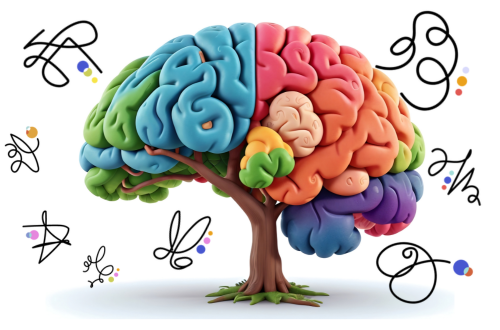Play, Presence, Possibility: ADHD & Creativity
October is ADHD Awareness Month, a time to widen the conversation about attention, focus, and the many ways a mind can move. Too often, ADHD is framed only through difficulty, such as distraction, disorganization, or impulsivity, without space for what is vibrant, creative, and human. At BCAT, we believe awareness also means appreciation. We invite a strengths-based perspective that honors imagination, curiosity, and humor as essential parts of ADHD.
ADHD is often described by what it takes away: focus, order, or the ability to remember where you put your keys (still missing by the way). Those challenges are real and deserve compassion. But they exist alongside a spark, a way of thinking and feeling that is inventive, open, and alive to connection. The ADHD brain notices patterns others miss, holds onto details that shimmer, and leaps into new ideas with energy that can be both exhilarating and exhausting. What feels like too many tabs open might actually be a mind that refuses to look away from possibility.
A wandering mind is not a broken one. What if wandering is simply a different route to understanding? Attention in ADHD does not always move in straight lines. It circles, drifts, loops, and lands when something resonates. Trusting that rhythm rather than constantly wrestling it can open the door to greater self-trust. A mind that moves differently is not unreliable by nature. It is responsive. It follows curiosity and meaning, even if that path looks unconventional.
Creativity often thrives in this landscape. Divergent thinking, or the ability to imagine many ways to solve a problem, comes naturally. So does curiosity, flexibility, and the capacity to hyperfocus on what truly matters. Creativity is not limited to art or performance. It appears in the way someone tells a story that makes others laugh, in how they find small workarounds that keep life moving, or in the humor that eases daily tension. It is a way of making sense of the world, a dialogue between impulse and insight.
Play is part of this dialogue too. For many people with ADHD, play is not a luxury. It is a way of regulating and connecting. Doodling during a meeting, tapping a rhythm on the desk, or cracking a joke in a tense moment are not signs of distraction. They are gestures of grounding, ways of saying, “I’m still here.” What might look like restlessness is often a nervous system finding its balance. What might look like being off-task is sometimes the body’s way of staying present.
Because the world around us constantly competes for attention, these small acts of presence matter. Our attention is not only shaped by what happens inside us but also by what surrounds us: the noise, the demands, the scrolling. Working with ADHD means learning not only how to redirect attention but also how to reclaim it from systems that never stop asking for it. There is quiet power in noticing when your focus has been pulled and choosing, even for a moment, where to bring it back.
When your attention gets stuck in loops such as replaying, worrying, or jumping ahead, try pausing long enough to name it. Then reorient gently through your senses: feel your feet, notice a sound, and take a breath that belongs only to you. These are small pivots, not perfect solutions. Each one reminds the nervous system that it has agency and that presence is still possible even in motion.
Creativity and play can support this practice. Before beginning a task, let your pen wander for a few minutes and see how your focus shifts afterward. If overwhelm feels big, use your hands to fold, shape, or draw what it feels like, then reshape it into something that represents calm. In conversation, experiment with saying “yes, and” instead of “yes, but.” It is a simple way to stay open to connection and soften the edges of rigidity.
Much of the conversation about ADHD centers on what is missing. Yet it is just as important to ask, What is working? What do I love about the way my brain moves? Humor, adaptability, empathy, and creativity often live right beside challenge. Naming these strengths does not erase the hard parts. It allows a more honest and compassionate picture of life with ADHD to emerge, a picture where attention, even when it wanders, can still be trusted.
Sometimes it can be difficult to hold onto that trust when the noise of daily life grows loud. This is where therapy can help. At BCAT, we integrate the arts and verbal psychotherapy to support clients with ADHD across the lifespan. Together, we explore how to regulate through creative expression, how to build systems that match your unique brain, and how to embrace ADHD as part of your story rather than something to fix. Therapy can be a space to rediscover self-compassion, reconnect with creativity, and learn tools that fit your nervous system. We meet you where you are, through play, presence, and connection.
ADHD can make life feel fast, full, and sometimes overwhelming. But it can also make life vivid and textured, filled with color and insight. When creativity and compassion work together, possibility expands. Let’s celebrate not only the challenges but also the wisdom, humor, and brilliance of minds that move differently.
Something to Try: The Spark Map
If you would like to explore what helps your energy and attention flow, try creating a simple Spark Map. Take a piece of paper and divide it into three parts.
Igniters
What lights you up? Perhaps music, color, movement, conversation, or time outside.
Dampers
What drains you? Maybe clutter, interruptions, harsh lighting, or self-criticism.
My Spark Start
What is one small ritual that helps you begin? You might doodle, stretch, play a song, or light a candle.
There are no right answers. The purpose is simply to notice what supports you so you can move through your days with more ease and a little more wonder.

